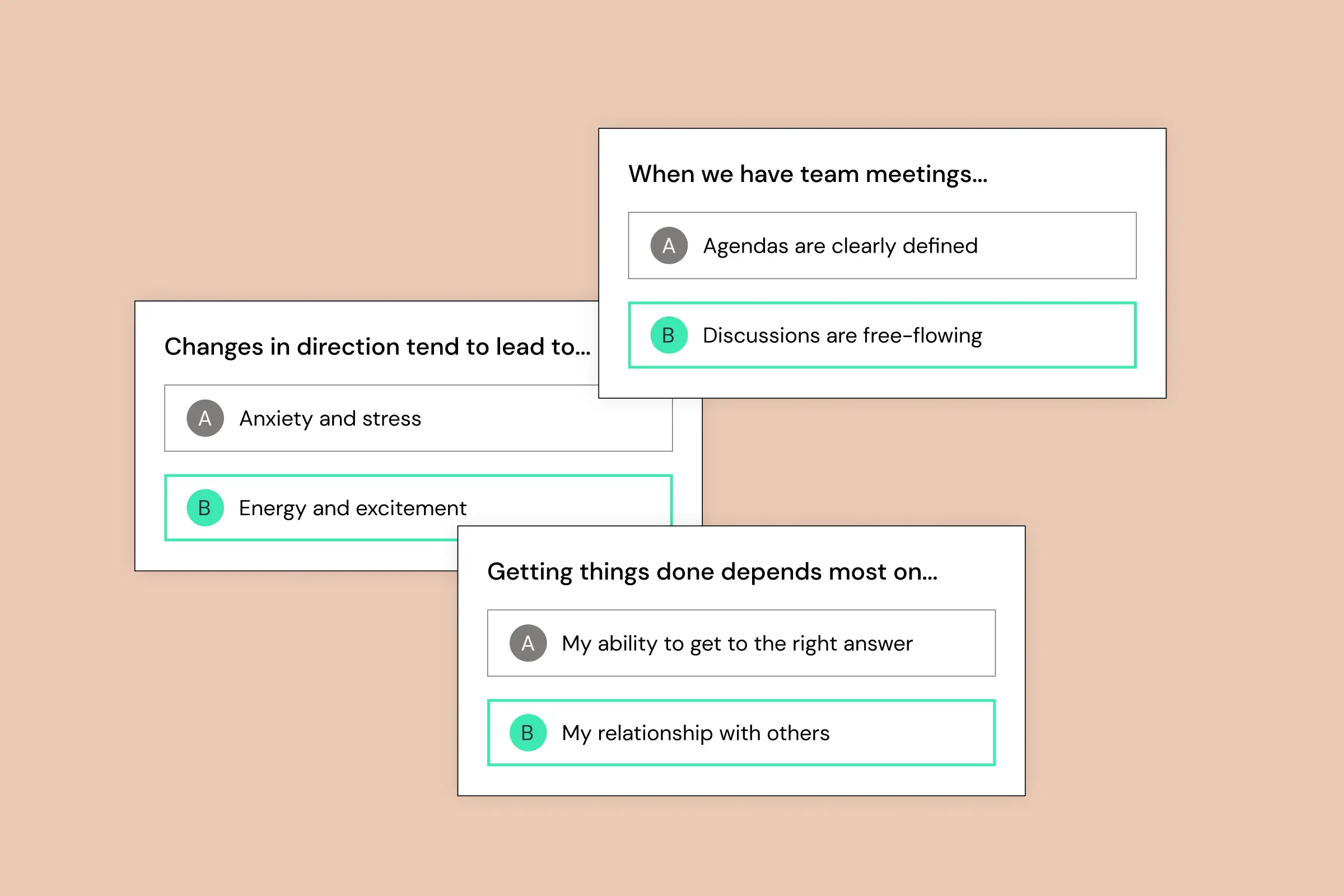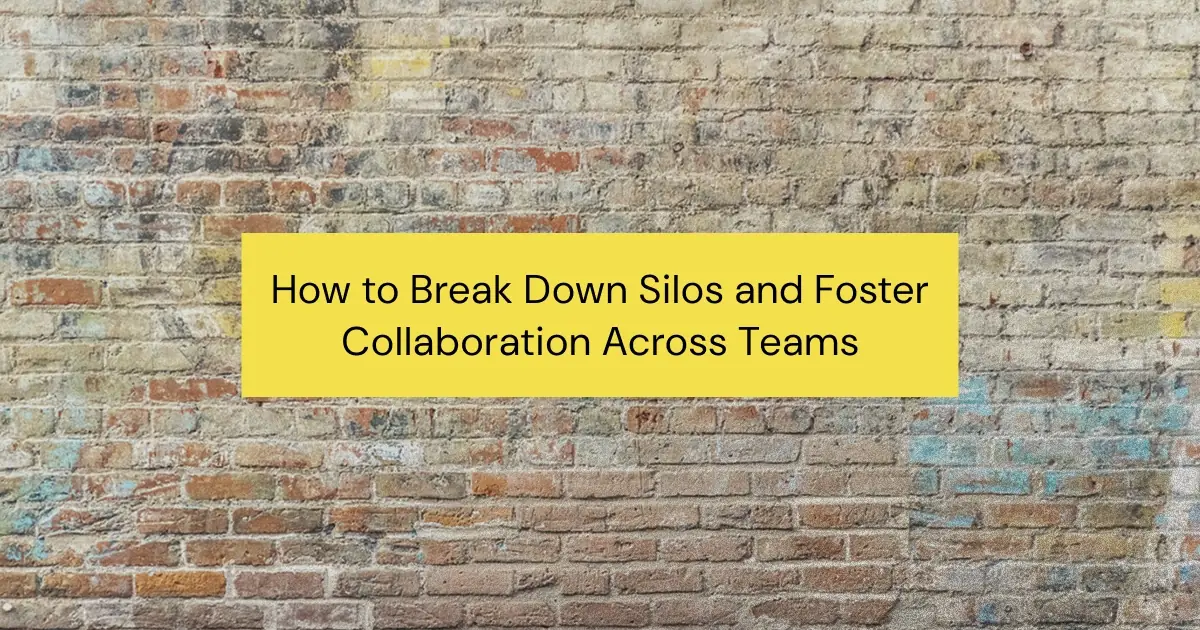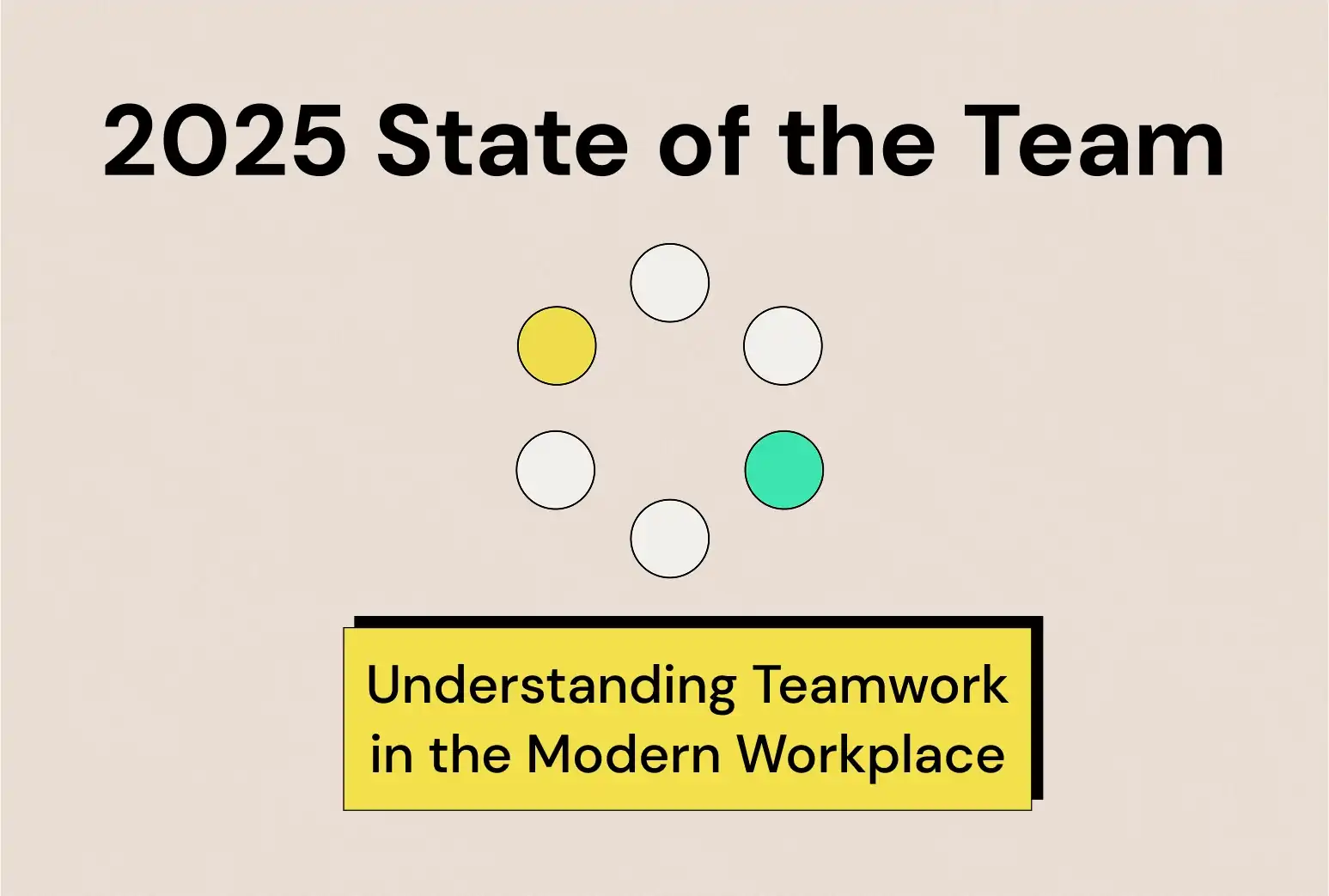Did you know that 80% of workers report “strongly pronounced” silos negatively impact their company's costs, innovation potential, culture, and profitability? That’s the price of teams working in isolation—missing out on ideas, duplicating efforts, and miscommunicating critical information.
But what exactly are “workplace silos”? Imagine different departments or teams in your company acting like islands—each with their own goals, tools, and processes, rarely communicating or collaborating with one another. This might seem harmless at first, but over time, these silos block innovation and stall progress.
For managers—especially those in fast-paced industries like tech or consulting—breaking down silos isn’t just a nice-to-have. It’s necessary for success. Teams need to be aligned, adaptable, and communicating effectively to keep up with rapidly shifting demands.
So, how do you start breaking those barriers? It begins with understanding your team's behavior at a deeper level. That’s where tools like TeamDynamics come in. By identifying patterns in how your team communicates, decides, and executes, you can uncover—and address—the root causes of silos.
Strategies for Breaking Down Workplace Silos
If you’re a manager looking to unlock your team’s full potential, let’s get started.
Foster Open Communication
If your teams aren’t talking to each other, they can’t work together effectively. It sounds simple, but poor communication is one of the top reasons workplace silos form. Everyone ends up working in their own little bubble, unaware of what’s happening outside their immediate team.
{{inline-cta}}
Start by increasing transparency. For example, hold regular cross-team updates where everyone shares what they’re working on. Don’t just use emails—use tools like Slack, Asana, or Trello to ensure this information is accessible to everyone as projects evolve.
But here’s the catch: no two teams communicate the same way. Some teams prefer formal updates in planned meetings, while others thrive on casual, spur-of-the-moment conversations. That’s where TeamDynamics comes in. Its “Communicating” dimension helps you see whether a team prefers “Ordered” communication (structured and defined) or “Informal” communication (organic and free-flowing). Armed with this insight, you can tweak how you share information to better fit how teams actually operate. It’s not about forcing people into meetings they hate—it’s about meeting them where they are.
Create Shared Objectives
Want to unite your teams? Give them a common purpose. Teams are more likely to collaborate when they’re working toward the same big-picture goal. Without it, everyone will stay laser-focused on their own priorities—which just deepens silos.
For example, instead of telling your development team to focus on speed and your marketing team to focus on branding, create a shared OKR (Objective and Key Result). Maybe something like, “Launch our new product to 5,000 users within three months.” Now, both teams have skin in the game. It’s no longer “our work versus theirs”—you succeed or fail together.
But there’s a trick to making this work: how your teams decide things matters. Some teams are “Concordant,” meaning they thrive on getting everyone to agree. Others are “Authoritative” and prefer quick decisions led by a manager. If you don’t know which style your teams fall into, you’re set up for frustration. Using TeamDynamics, you can pinpoint these tendencies and make sure everyone is actually included in goal-setting conversations—not steamrolled or left out.
Build a Culture of Empathy and Accountability
Silos aren’t just about process—they’re about people. Most silos form because teams don’t fully trust or understand each other. Think of that time when engineering complained that marketing “doesn’t get deadlines” or when finance accused product teams of being “too carefree with the budget.” It’s not productive, but it’s real.
To fix this, focus on building empathy. Host joint problem-solving sessions or schedule team-building activities where groups actually work together outside their daily grind. A great example is cross-functional workshops, where teams brainstorm solutions to shared problems. It’s not fluffy—it’s strategic.
Here’s where TeamDynamics adds real value. Its “Processing” dimension reveals whether a team evaluates information relationally (based on the source) or logically (based on the facts). This can uncover hidden patterns behind communication breakdowns. For instance, if one team doesn’t trust information from another, it probably has less to do with the data itself and more to do with who’s delivering it. When managers address these relationship gaps, collaboration improves overnight.
Encourage Cross-Team Collaboration Opportunities
If you want teams to collaborate, give them opportunities to actually work together. Otherwise, they’ll stay in their comfort zones.
Start small: invite people from other teams to join key meetings or shadow different departments for a week. Then, get creative. Run a cross-department mentorship program where team members exchange insights on how they work. You could even try temporary “team swaps,” where someone from one team works with another for a short-term project. These initiatives help people see the bigger picture and appreciate the challenges their colleagues face.
But here’s a heads-up: collaboration only works if your teams can handle differences in how they get work done. For example, a “Deliberate” team that likes detailed plans will struggle to team up with a “Spontaneous” group that prefers flexibility. TeamDynamics flags these execution styles so you can plan collaborations that actually work. For example, if you know a team prefers spontaneity, you might give them more freedom in how they complete shared tasks, helping them avoid conflicts with “by-the-book” teams.
Breaking down silos doesn’t happen overnight, but these strategies are practical steps any manager can take. And with tools like TeamDynamics, you don’t have to guess how your teams work—you have data to guide you.
Measuring Success in Cross-Team Collaboration
So how can you measure your team's progress in cross-team collaboration?
Key Metrics for Collaboration Improvements
Breaking down silos is great, but how do you know if it’s working? You need to track real results. Here are a few concrete things to measure:
- Knowledge-sharing frequency: Are teams sharing updates more often? For example, are marketing and product teams holding regular syncs to ensure campaigns reflect the latest product features?
- Quicker decisions: Are projects moving faster? If one team used to wait weeks for input from another department, are they now getting answers in days?
- Engagement and morale: Employees frustrated by their ideas hitting department "walls" often disengage. Keep an eye on your employee satisfaction surveys. Are scores improving since collaboration efforts began?
The biggest win? These changes don’t just help the team—they make you, as a manager, look like a collaboration hero.
Use Ongoing Feedback to Reveal Progress
Improving collaboration isn’t a “set it and forget it” exercise. You need constant check-ins to course-correct.
Start small: Add a quick question to your team’s weekly or monthly retrospectives. Something like:
- “What’s one thing that went well collaborating with other teams this week?”
- “Where did communication with other teams break down?”
Don’t stop at surveys. Have real conversations. For example, if your engineering team says they’re still frustrated by vague feedback from design, dig deeper.This is where TeamDynamics shines. When you know how different teams work—whether they’re Concordant decision-makers, Logical processors, or Spontaneous executors—you can quickly spot why things feel off. More importantly, you can fix it.By combining these feedback loops with TeamDynamics insights, you can track visible collaboration wins and uncover hidden problems before they derail progress. At the end of the day, strong leadership isn’t just about solving problems—it’s about stopping them before they even start.
Why TeamDynamics is the Ultimate Tool for Breaking Down Silos
Here’s the truth: Workplace silos don’t exist because people aren’t talented or hardworking. They exist because teams don’t align. Different communication habits, decision-making processes, and work styles cause teams to disconnect, even when they share the same goals. That’s why tools that only analyze individuals, like MBTI or StrengthsFinder, won’t fix silos. Silos are a team problem—and solving them requires a team-focused solution. Enter TeamDynamics.
Traditional Personality Tests Miss the Point
Many managers turn to personality tests, hoping to address workplace issues. But here’s the issue: These tools focus on individual traits and styles. While it’s helpful to know that Sarah is an introvert or that Carlos prefers “big picture” thinking, these insights won’t tell you why Sarah and Carlos’s teams struggle to collaborate—or why your whole department feels stuck.
TeamDynamics flips this approach on its head. Instead of looking at isolated individuals, it focuses on how a team behaves as a unit. It helps you see patterns in how your team communicates, processes information, makes decisions, and executes work. These collective behaviors are the root cause of silos—and they’re exactly what TeamDynamics helps you fix.
How TeamDynamics Breaks Down Silos
When you understand your team’s collective dynamic, tackling silos becomes easier. Here’s how TeamDynamics helps:
1. Diagnoses Communication Gaps
Does your team prefer structured updates (Ordered), while another team loves impromptu chats (Informal)? Guess what? That’s a classic recipe for miscommunication. TeamDynamics identifies these mismatches, so you can adjust your workflows and share information in ways that work for everyone.
Example: If your marketing team hates long emails, but your product team lives by detailed reports, you might introduce a quick weekly sync (bridging “Ordered” and “Informal” preferences) to share what matters most.
2. Aligns Decision-Making Styles
Ever noticed one team thrives on all-member discussions (Concordant), while another prefers calls made at the top (Authoritative)? That divide creates tension fast. TeamDynamics shows where these differences exist, so you can balance consensus-building with clear leadership direction.
Example: Suppose your engineering team wants every feature vote to include everyone, but your leadership team expects decisions handed down quickly. You might agree to let engineers brainstorm solutions together but stick to leadership-approved timelines. No more bottlenecks; no more frustration.
3. Adapts Plans to Fit Execution Styles
Some teams love detailed project plans (Deliberate), while others prefer to stay agile and adjust as they go (Spontaneous). If these approaches clash, collaboration can feel like chaos. TeamDynamics helps you find a middle ground.
Example: When a deliberate team leads a big initiative—including a spontaneous team—TeamDynamics might recommend building flexible “checkpoints,” where quick pivots can be discussed within established project milestones.
More Than Awareness: Actionable Insights for Better Collaboration
Here’s the best part: TeamDynamics doesn’t just give you data and leave you guessing. It delivers actionable insights you can actually use. By identifying which of the 16 team types your group fits into, it offers tailored advice for building workflows, decision frameworks, and communication plans that break down silos for good.
Ready to Take Control of Your Team?
TeamDynamics isn’t a nice-to-have—it’s the missing piece for managers who want to build stronger, more collaborative teams. If you’re tired of silos slowing your progress, try TeamDynamics. You can finally stop guessing why collaboration isn’t working and start making real change.
Silos thrive when teams don’t understand each other. TeamDynamics makes sure that’s never the case. Take the first step today. Visit TeamDynamics.io.
Overcoming Roadblocks When Breaking Down Silos
Let’s face it—breaking down silos is easier said than done. Resistance to change, lack of time, and even fear of failure can all make the process feel like an uphill battle. But here’s the truth: these roadblocks aren't as immovable as they seem. With the right mindset and tools, you can tackle them head-on and start seeing real progress.
Resistance to Change
People don’t like change. It disrupts their routines, creates uncertainty, and can feel threatening. This is especially true in workplace silos, where teams cling to familiar ways of working because "that's how we've always done it."
Here’s the fix: Focus on small, manageable changes instead of overhauling everything at once. For example, start with one simple idea, like inviting someone from another department to your team’s weekly meeting. A tiny step like this can normalize collaboration across teams without making anyone uncomfortable.
And let’s be honest—resistance often stems from a lack of trust. This is where TeamDynamics shines. If you know your team leans toward "Relational" processing (meaning they factor in who’s delivering the information), you can tailor how you pitch changes to win them over. It's about speaking their language and building trust one interaction at a time.
Lack of Time
How often have you heard this? "We don’t have time to collaborate—we’re drowning in deadlines!" Silos persist because teams are so busy focusing on their own tasks that they forget to look up and see the bigger picture.
The reality? Silos waste more time than they save. How many hours have you spent waiting for another team to send over critical information or fixing mistakes caused by poor communication?
Here’s the fix: Make collaboration a priority by carving out dedicated time for it. Try implementing a monthly "bridge-the-gap" meeting where teams share updates and solve common problems together. And don’t stop there—use tools like shared documents or project management platforms so cross-team communication becomes part of your normal workflow, not just an occasional add-on.
With TeamDynamics, you can take it a step further by aligning collaboration tactics to how teams execute work. If one team thrives on "Deliberate" plans and another prefers "Spontaneous" workflows, you can create a structure that respects both styles. That way, meetings and processes don’t feel like extra work—they feel natural.
Fear of Losing Control
Here’s an uncomfortable truth: some managers fear collaboration because it feels like losing control. When other teams weigh in or influence decisions, it can feel like your authority is being challenged. And in hierarchical workplaces, that fear can trickle down, reinforcing silos.
But here’s the flip side: true leadership isn’t about control—it’s about outcomes. Collaboration isn’t a threat. It’s an opportunity to bring in diverse perspectives and make better decisions.
Here’s the fix: Lead by example. If other teams are hesitant to share resources, offer yours first. If decision-making feels like a turf war, suggest a more open process—something that finds a balance between "Concordant" and "Authoritative" decision styles. For instance, propose that your team sets the agenda, but let the other teams weigh in on priorities. Small gestures like this can make joint decision-making feel like a win-win instead of a power struggle.
Tools like TeamDynamics help with this transition by spotlighting team behaviors that unintentionally block collaboration. You can use these insights to guide yourself—and your team—toward more inclusive leadership without feeling like you’re losing control.
Misaligned Goals
Imagine this: your marketing team is pushing for more website visitors, but your sales team only cares about qualified leads. Here’s the problem—when you reward teams based on competing metrics, they’ll compete with each other. Silos thrive in environments where goals don’t align.
Here’s the fix: Create shared goals that require cross-team input. For example, instead of just focusing on website traffic, make the goal “Increase revenue from web visitors” and include milestones from both marketing (driving traffic) and sales (closing deals). When one team’s success depends on another’s input, people are forced to collaborate. And it works.
TeamDynamics can be a game-changer here, too. By identifying how different teams approach decision-making, you can set joint goals in a way that works for everyone. For instance, a "Logical" team might want measurable data to back decisions, while a "Relational" team might be more influenced by how the goals impact team members directly. Recognizing this difference helps you set goals everyone can rally behind.
Breaking down silos isn’t easy, but it’s doable. Teams resist change, feel short on time, or fear losing control—but as a manager, you have the power to push through these challenges. With TeamDynamics as your secret weapon, you can identify the behaviors holding your team back and take concrete steps toward fostering collaboration. Remember, change starts small. Tackle the roadblocks one by one, and watch your team transform.
Build Bridges Between Team Behaviors for Seamless Collaboration
Every team approaches work differently, and that’s both a blessing and a challenge. Some teams thrive on structure and plans (Deliberate), while others embrace agility and go-with-the-flow problem-solving (Spontaneous). Similarly, one group might make decisions in a leader-driven, top-down style (Authoritative), while another relies on consensus and group buy-in (Concordant). These differences can create real tension when teams have to work together—or they can become opportunities for innovation if handled the right way.
Here’s the hot take: The real reason teams struggle to collaborate isn’t because they don’t get along, but because they don’t understand how the other team works. Instead of fighting this, managers need to act as bridge-builders. You don’t just fix the gaps—you connect the dots between competing styles to get the best of both worlds.
Tangible Example: A Tale of Two Teams
Picture this: Your product team prefers a laid-back, adaptive approach to deadlines (Spontaneous), while the marketing team lives and dies by campaigns planned months in advance (Deliberate). The clash happens fast. Marketing accuses Product of being disorganized. Product thinks Marketing is rigid. Cue frustration, missed timelines, and lots of eye-rolling. Sound familiar?
Here’s what a great manager does in this situation: Instead of forcing one team to conform to the other’s style, you create a hybrid workflow that respects both approaches. Use the structured deadlines Marketing wants but leave gaps for Product’s last-minute creativity. The result? A campaign that feels both innovative and well-executed. Win-win.
How TeamDynamics Makes This Easier
This is exactly where TeamDynamics comes in. You won’t just slap labels like "creative" or "disciplined" on your teams and hope for the best. Instead, TeamDynamics helps you dive deeper by showing you why your teams get stuck: Do they struggle because their communication is too informal? Or is it because their decision-making styles clash? By understanding the “why,” you get to the solutions faster.
For instance, if the friction lies in how teams process information (one Logical, one Relational), you could introduce activities that create shared understanding—like holding meetings where feelings and hard data both have equal weight in the discussion. That’s the kind of insight that turns tension into collaboration.
If you’re serious about breaking down silos, stop focusing on changing people and start focusing on aligning behaviors. Different styles don’t have to be a barrier; they can be a strategy for better outcomes. But you can’t manage what you don’t understand, which is why tools like TeamDynamics are your secret weapon. They help you see your teams not as individuals struggling to get along but as collective systems you can fine-tune. Once you do that, collaboration stops feeling like a task. It becomes the default.
Manager to manager: Build the bridges your teams need, and watch what happens when behavioral clashes disappear from your meetings. You’ll spend less time mediating and more time growing your business. Isn’t that the goal?
Conclusion: Start Breaking Down Workplace Silos Today
Workplace silos don’t just hurt collaboration—they drain time, money, and productivity from your organization. They prevent talented teams from working together, make information harder to find, and stifle innovation. But silos aren’t inevitable. With the right mindset and tools, you can dismantle them.
It starts with understanding your team. How does your group communicate? How do they process information, make decisions, and execute plans? These behaviors shape every interaction. By identifying and addressing misalignments in these areas, you can build bridges between teams, create shared goals, and foster better collaboration.
Tools like TeamDynamics make this process easier. By focusing on how your team works as a whole—not just on individual personalities—it gives you practical insights to align communication, decision-making, and execution styles across teams.
So, don’t let silos hold your team back any longer. Take action today. Explore how TeamDynamics can help you break barriers, connect teams, and unlock smoother workflows. The good news? Turning struggling teams into cohesive, powerhouse collaborators is entirely possible with the right strategy. It’s time to lead with intention and see what your team can achieve together.




.png)







































